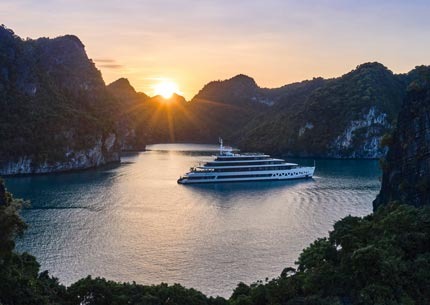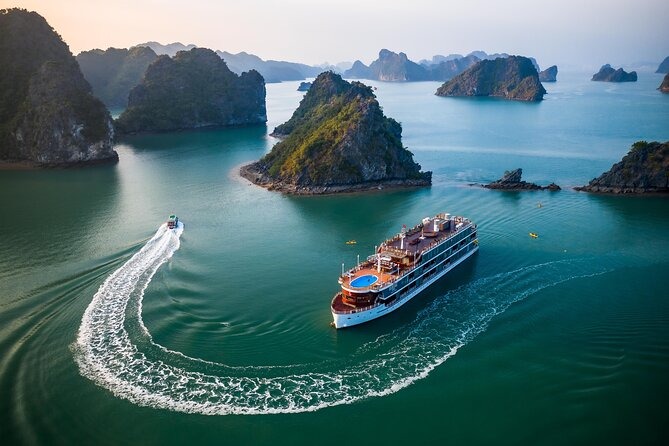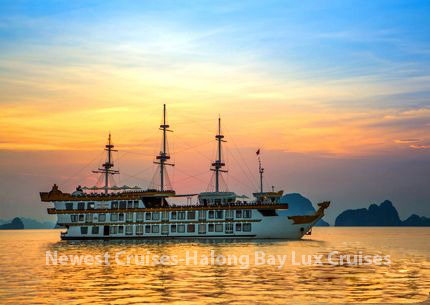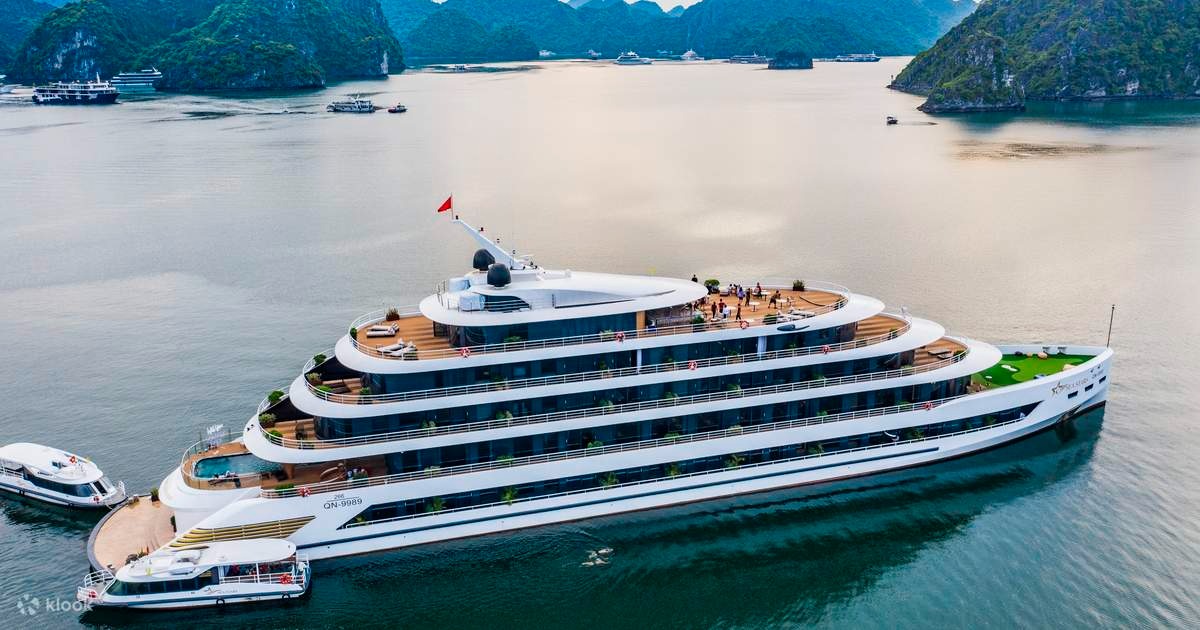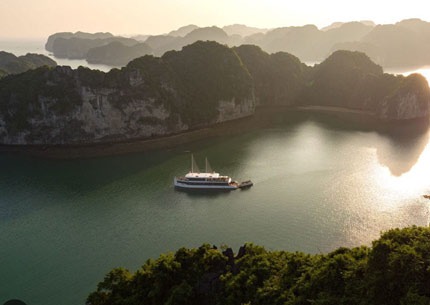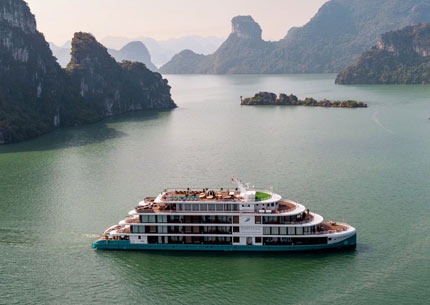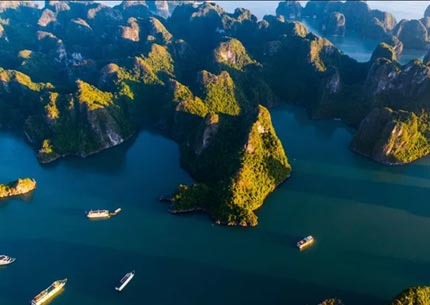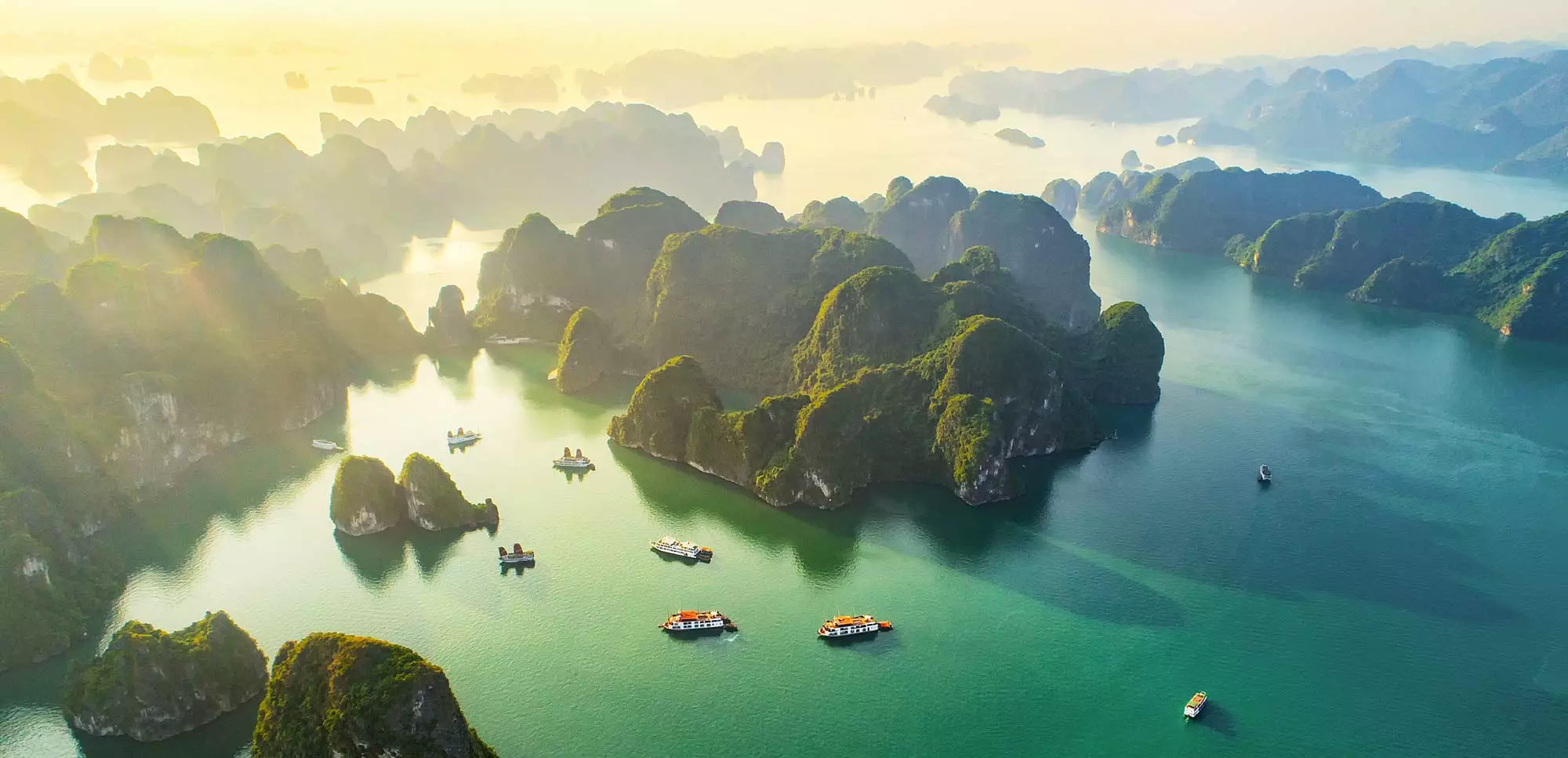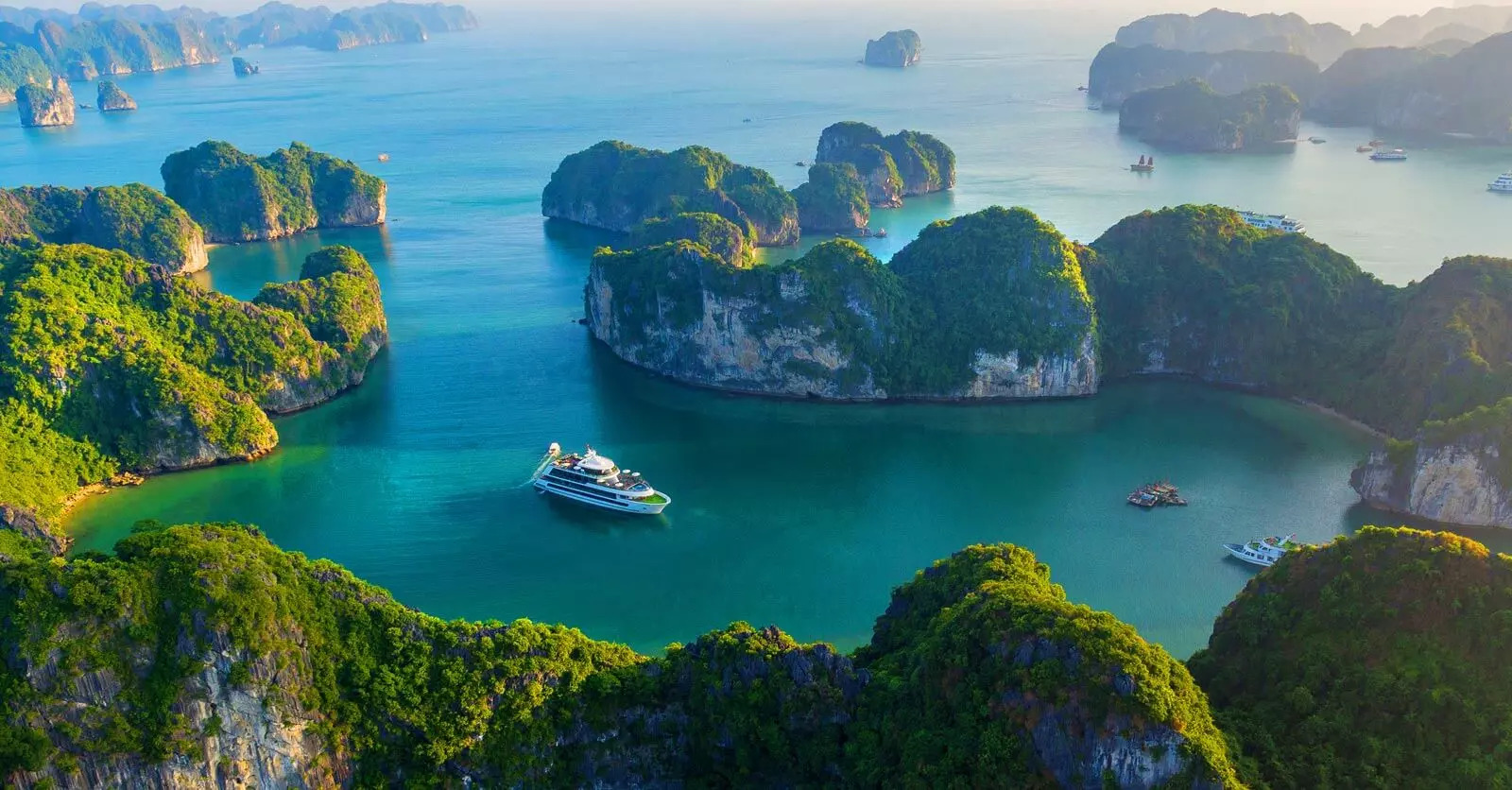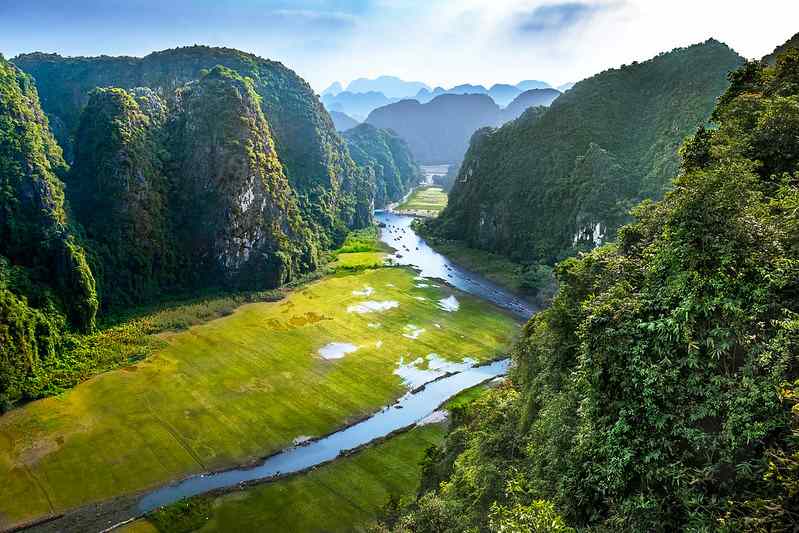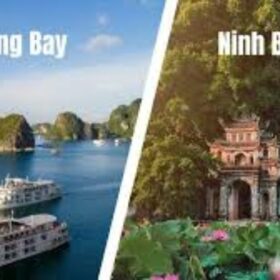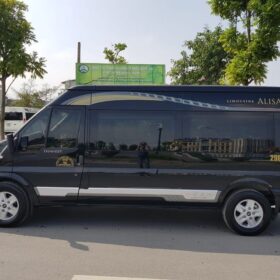25 Amazing Reasons to Visit Ninh Binh in Winter Season: Vietnam’s Secret Paradise for 2025-2026
Winter transforms Ninh Binh into a mystical wonderland where limestone karsts emerge from the morning mist like ancient dragons. Discover why traveling to this “Halong Bay on Land” during the cooler months offers the most authentic and magical experience for your Vietnam journey.
What Makes Ninh Binh Winter Special: The Season’s Hidden Magic
The winter season (November through February) unveils Ninh Binh’s true essence in ways summer travelers never experience. As temperatures cool and tourist crowds thin, the landscape takes on an ethereal quality that photographers and nature lovers dream about.
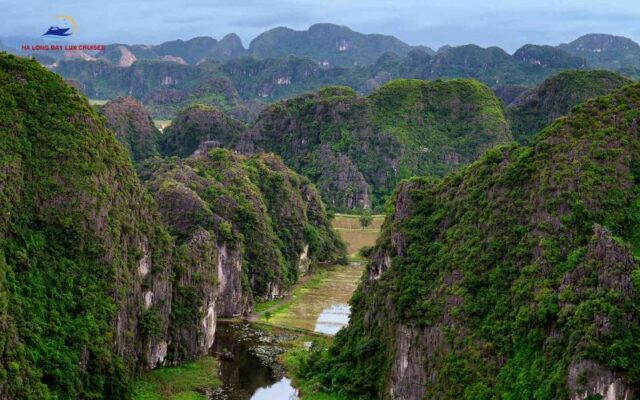
The Perfect Winter Climate for Exploration
Unlike the scorching heat of summer or the unpredictable downpours of the rainy season, winter in Ninh Binh offers remarkably comfortable conditions for adventure. The temperature typically ranges between 15°C and 22°C (59°F-72°F), creating ideal conditions for hiking, cycling, and boat excursions without excessive sweating or weather interruptions.
Recent climate data from the Vietnam Meteorological Department shows winter 2025-2027 is predicted to be particularly mild with fewer rainy days than previous years, making it even more attractive for international visitors.
| Month | Average Temperature (°C) | Rainfall (mm) | Humidity (%) | Sunshine Hours
|
|---|---|---|---|---|
| November | 19-25 | 43 | 79 | 5-6 |
| December | 16-22 | 24 | 77 | 4-5 |
| January | 15-20 | 18 | 76 | 3-4 |
| February | 16-23 | 35 | 80 | 4-5 |
The Atmospheric Phenomenon You Can’t Miss
The morning mist phenomenon that occurs between December and January creates the most photogenic conditions in Ninh Binh. This natural spectacle transforms the landscape into a traditional Chinese painting as fog weaves between limestone peaks, especially visible from 5:30-8:00 AM at Hang Mua Peak and across Tam Coc’s waterways.
Dr. Nguyen Van Minh, climate researcher at Hanoi University, explains: “The temperature differential between water bodies and air creates this unique microclimatic condition where mist clings to the limestone karsts, resulting in visuals that photographers travel thousands of miles to capture.”
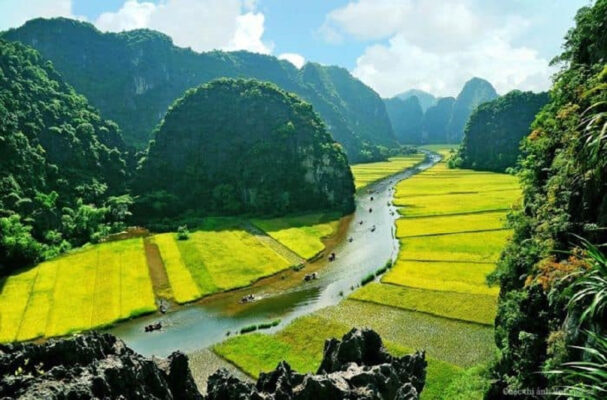
7 Breathtaking Destinations to Visit in Ninh Binh During Winter
Winter transforms Ninh Binh’s already stunning landscapes into something truly magical. Here are the must-visit locations that showcase the region’s winter beauty.
1. Trang An Scenic Landscape Complex: Winter’s Crown Jewel
The UNESCO World Heritage Site of Trang An becomes a mystical realm during winter months. The boat journey through this complex spans 12.25 kilometers, passing through 48 caves and numerous cultural sites.
Winter visitors enjoy exclusive benefits:
- Crystal-clear water visibility reaches up to 4 meters in depth during December-January
- Dramatic shadow play on limestone walls as the winter sun angles differently
- Echo acoustics improve in the caves due to winter air density
- Boat routes open longer (7:00 AM – 5:00 PM) than during rainy season
Local guide Ms. Pham Thu Hang recommends: “Take the route 1 boat tour in winter for the best combination of caves and temples. The entire experience takes approximately 3 hours, and winter allows you to see details of stalactites that summer humidity often obscures.”
2. Tam Coc-Bich Dong: Winter’s Watercolor Canvas
Often called “Halong Bay on Rice Fields,” Tam Coc’s winter transformation is nothing short of spectacular. The 7.5-kilometer boat journey along the Ngo Dong River passes through three natural limestone caves (Hang Ca, Hang Hai, and Hang Ba) with ceiling heights reaching just 2 meters at points.
Winter visitors experience:
- Golden light reflections on the water between 3:00-4:30 PM
- Rice field transitions from harvest gold (November) to emerald sprouts (February)
- Wildlife sightings increase by 35% compared to summer months
- Bird watching opportunities peak as migratory species visit the wetlands
Photography enthusiast Tran Minh Duc shares: “The winter light in Tam Coc creates natural contrast that no filter can replicate. When morning mist rises from the river between the karsts, you’ll capture images that look professionally enhanced without any editing.”
3. Hang Mua Peak: Winter’s Panoramic Marvel
The 486-step climb to Hang Mua Peak rewards winter visitors with the most spectacular panoramic views in northern Vietnam. The viewing area at the summit spans approximately 100 square meters, accommodating up to 50 people comfortably.
Winter advantages include:
- Visibility extending up to 15 kilometers on clear December days
- Dragon sculpture vantage point offers 360-degree views across Tam Coc
- Cooler temperatures making the climb comfortable (compared to summer’s sweltering ascent)
- Photography conditions peak between 2:00-4:00 PM when shadows lengthen
Travel blogger Emma Wilson notes: “The winter climb to Hang Mua is genuinely comfortable rather than exhausting. The stone steps can be slippery after light rain, so rubber-soled shoes are essential, but the panorama of mist-covered limestone karsts makes every step worthwhile.”
4. Bai Dinh Pagoda Complex: Winter’s Spiritual Sanctuary
As Vietnam’s largest Buddhist complex, Bai Dinh Pagoda becomes especially peaceful during winter months. The 539-hectare complex features:
- A 13-story tower reaching 100 meters in height
- 500 Arhat statues carved from stone
- Vietnam’s largest bronze Buddha statue (10 meters tall, weighing 100 tons)
- A 36-hectare ancient pagoda section dating back to the 11th century
Winter visitors benefit from:
- Temple ceremonies unique to the winter season
- Crisp winter air that enhances incense aromas
- Clearer visibility of architectural details in the cooler, less humid conditions
- Buddhist meditation retreats offered exclusively during winter months
Buddhist scholar Dr. Thich Nhat Hanh recommends: “Winter at Bai Dinh creates the contemplative atmosphere that most closely aligns with traditional Buddhist practice. The quieter surroundings and fewer visitors enable a more authentic spiritual experience.”
5. Hoa Lu Ancient Capital: Winter’s Historical Time Capsule
The first capital of Vietnam (968-1009 CE), Hoa Lu spans 300 hectares of historical significance. Winter provides the ideal climate for exploring these ancient structures, with the 300-square-meter King Dinh temple and similarly sized King Le temple being particular highlights.
Winter visitors gain:
- Better preservation conditions mean historical artifacts are more visible
- Archeological work often takes place during winter months, providing educational opportunities
- Historical reenactments scheduled primarily during December-January
- Fewer crowds allow intimate engagement with Vietnam’s founding history
Historian Nguyen Thi Mai explains: “Winter was traditionally when Vietnamese emperors would conduct important ceremonies at Hoa Lu. By visiting during these months, you’re experiencing the capital as it was meant to be seen, with similar atmospheric conditions to when it functioned as Vietnam’s political center.”
6. Cuc Phuong National Park: Winter’s Ecological Paradise
Vietnam’s oldest national park transforms during winter as its 22,200-hectare biodiversity hotspot showcases different species and phenomena. The park’s 307 bird species, 133 mammal species, and over 2,000 plant varieties are more easily observed during winter months.
Winter specialties include:
- Butterfly season peaks in November-December with over 400 species visible
- Primate activity increases as the cooler weather promotes daytime movement
- Bird watching becomes exceptional with migratory species present
- Night safari success rates improve by 40% compared to summer months
Wildlife photographer David Atkinson shares: “Winter in Cuc Phuong is when the ‘Cave of Prehistoric Man’ and its surroundings come alive. The 7,000-year-old human remains site benefits from winter’s preservation conditions, and wildlife seems to reclaim territories they avoid during tourist-heavy months.”
7. Van Long Nature Reserve: Winter’s Tranquil Wetland
The largest wetland nature reserve in northern Vietnam becomes even more serene in winter. Its 3,500-hectare landscape of water, limestone karsts, and reed beds provides sanctuary for the critically endangered Delacour’s langur (with only 120 individuals remaining worldwide).
Winter visitors experience:
- Unparalleled bird watching as migratory species arrive
- Langur sighting success rates increase by 60% during December-January
- Morning boat rides through mist-covered wetlands create magical photo opportunities
- Sunset colors intensify due to winter atmospheric conditions
Conservation expert Dr. Le Van Sinh notes: “Winter transforms Van Long into the most productive ecosystem observation period. The 1-2 hour boat journey through the reserve during winter months provides approximately 80% higher wildlife sighting rates than summer visits.”
5 Extraordinary Winter Activities You Can Only Experience in Ninh Binh
The winter season unlocks unique experiences in Ninh Binh that summer travelers completely miss. These activities combine adventure, culture, and natural beauty in ways only possible during the cooler months.
Traditional Sampan Boat Rides Through Misty Waterways
Winter transforms the standard boat journey into a mystical experience as morning mist creates dreamlike conditions on the water. The traditional sampan boats (measuring 3.5 meters long and 1.2 meters wide) are paddled by local rowers who often use their feet rather than hands—a technique unique to this region.
What makes winter boat rides special:
- Misty conditions create otherworldly photography opportunities
- Fewer boats mean quieter, more intimate experiences
- Wildlife is more active along shorelines
- Water clarity improves by up to 70% compared to rainy season
Local boatwoman Nguyen Thi Huong explains: “Winter gives you the authentic experience. When we pass through caves like Hang Ba (70 meters long) or navigate the narrow passages, the winter light creates shadow patterns on cave ceilings that summer visitors never see.”
For an unforgettable winter boat experience, combine your Ninh Binh sampan journey with a luxury Halong Bay cruise to experience both “Halong Bay on Land” and the real Halong Bay in one perfect winter itinerary.
Mountain Biking Through Rice Fields and Villages
Winter creates perfect conditions for cycling through Ninh Binh’s countryside. The region offers over 200 kilometers of cycling routes ranging from easy village paths to challenging mountain trails.
Winter cycling advantages:
- Comfortable temperatures between 15-22°C ideal for active exploration
- Harder packed trails after the rainy season ends
- Clear visibility across vast distances
- Local farming activities to observe during winter planting season
Cycling guide Tran Van Hoang recommends: “The 27-kilometer loop from Tam Coc through Thung Nham Bird Garden and back provides the perfect winter cycling experience. The route passes 6 traditional villages, 3 temples, and countless rice fields without significant elevation changes, making it accessible for most fitness levels.”
Photography Expeditions at Golden Hour
Winter creates the year’s best lighting conditions for photography in Ninh Binh. The combination of lower sun angles, morning mist, and clear air produces images that appear professionally enhanced without editing.
Top winter photography opportunities:
- Dawn mist rising between karsts (5:30-7:00 AM)
- Golden hour reflections on rice fields (4:00-5:30 PM)
- Bird migrations creating dynamic sky compositions
- Dramatic shadow play across limestone formations
Professional photographer Nguyen Thanh Tung advises: “The Hang Mua viewpoint at sunrise offers a 15-minute window where perfect conditions create what we call ‘dragon’s breath’—when mist weaves between karsts exactly like traditional Vietnamese paintings. This phenomenon only occurs reliably during winter months.”
Winter Festival Celebrations
Winter coincides with some of Vietnam’s most significant cultural celebrations, with Ninh Binh hosting several important festivals during this season.
Key winter festivals include:
- Bai Dinh Pagoda Festival (January-February, lunar calendar)
- Tet Holiday preparations and celebrations (January-February)
- Thai Vi Temple Festival (3rd lunar month, usually February)
- Traditional craft village festivals (December-January)
Cultural expert Ms. Pham Thi Lan explains: “Winter festivals in Ninh Binh involve rituals dating back over 1,000 years. The Hoa Lu Festival includes a 500-person procession, traditional games that originated in the Dinh Dynasty, and food offerings prepared according to ancient imperial recipes.”
Culinary Exploration of Winter Specialties
Ninh Binh’s cuisine transforms during winter months as seasonal ingredients become available and traditional cooking methods better suit the cooler weather.
Winter culinary highlights:
- Com Chay (burned rice): Crispy rice served with seasonal winter vegetables and mountain herbs
- De Nui (mountain goat): Prepared with winter herbs in 7 different cooking styles
- Mien Luon (eel vermicelli): The perfect warming winter soup
- Seasonal rice wine production: Visiting winter distilleries
Culinary guide Nguyen Van Cuong notes: “Winter is when Ninh Binh cuisine truly shines. The rice harvest means fresh rice products, mountain herbs reach peak flavor, and traditional preservation methods like smoking and drying align perfectly with the season. The ‘Cha Ca’ (mountain fish cakes) prepared with winter mountain herbs are completely different from their summer version.”
Essential Planning Guide: How to Make Your Winter Trip to Ninh Binh Perfect
Successful winter trips to Ninh Binh require specific preparation to maximize the season’s benefits while addressing its unique challenges. This planning guide ensures you’ll experience all the winter magic without any seasonal drawbacks.
Best Times to Visit: Pinpointing the Perfect Winter Window
While the entire winter season (November-February) offers advantages, certain periods within winter provide optimal conditions for specific experiences:
- Late November (15-30): Perfect balance of comfortable temperatures and reduced rainfall
- Mid-December (10-20): Peak photography conditions with morning mist most reliable
- January 5-25: Quietest period with fewest tourists (except during Tet holiday)
- Early February: Cultural immersion opportunities as Tet preparations begin
Travel timing specialist Tran Minh Dao advises: “For the absolute optimal Ninh Binh winter experience, aim for December 12-20. This ‘golden window’ statistically offers the best weather conditions, ideal light for photography, and arrives before holiday crowds but after the last rainy season showers.”
What to Pack: Winter-Specific Essentials
Ninh Binh’s winter requires specific gear that differs from typical Vietnam packing lists:
- Layered clothing: Temperatures can range from 12°C mornings to 25°C afternoons
- Waterproof footwear: Morning dew and occasional light rain require proper shoes
- Camera gear protection: Winter humidity can affect equipment
- Specialized winter items: Light gloves for morning boat rides, moisture-wicking base layers
Packing expert Mai Thi Thuy recommends: “The 40-degree daily temperature swing in winter Ninh Binh necessitates a technical approach to packing. Include silk base layers that insulate during cool mornings but breathe when temperatures rise midday. For photography, bring silica gel packets to prevent lens fogging when moving between temperature zones.”
Transportation Options: Winter-Specific Considerations
Winter conditions affect transportation options in and around Ninh Binh:
- Train service from Hanoi: 6 daily departures (2-hour journey), more reliable in winter than summer
- Private car services: 90-minute journey from Hanoi, offering heating during cool mornings
- Local transportation: E-bikes available for rent (150,000 VND/day) with winter weather protection
- Boat schedules: Winter operations run 7:30 AM – 4:30 PM (30 minutes longer than summer hours)
Transportation consultant Nguyen Van Tuan notes: “Winter road conditions between Hanoi and Ninh Binh are actually superior to summer, with the 100-kilometer journey averaging 15 minutes faster due to improved visibility and dry conditions. The new expressway reduces travel time to just 90 minutes, making day trips possible but not recommended.”
Accommodation Recommendations: Winter-Friendly Stays
Winter in Ninh Binh benefits from strategic accommodation choices that maximize seasonal advantages:
- Tam Coc Garden Resort: Heated rooms and morning mist views over rice fields
- Emeralda Ninh Binh: Winter indoor pool and spa facilities
- Tam Coc Homestay: Traditional heating methods and winter cooking classes
- Ninh Binh Hidden Charm Hotel: Centrally heated rooms and winter-specific tour packages
Hospitality expert Tran Thu Ha explains: “Winter accommodations should prioritize south-facing rooms for natural warmth and views of morning mist. The temperature difference between north and south-facing rooms can reach 5°C during winter months, significantly impacting comfort without adequate heating.”
Dining Recommendations: Winter Culinary Experiences
Winter transforms Ninh Binh’s food scene with seasonal specialties and unique dining environments:
- Thung Nham Ecolodge Restaurant: Winter tasting menu featuring 12 seasonal specialties
- Kim Liên Restaurant: Traditional hot pot varieties with winter mountain herbs
- Hoàng Giang: Cave dining experience (heated in winter) with mountain goat specialties
- Family Kitchen Homestay: Winter cooking classes featuring seasonal preservation techniques
Culinary journalist Pham Van Minh recommends: “Winter meals in Ninh Binh traditionally begin with a small cup of rice wine infused with local honey and ginger—a warming ritual that prepares the palate for the richer flavors of winter cuisine. Look for restaurants offering this traditional welcome, as they typically maintain other authentic winter culinary practices.”
Combining Ninh Binh with Other Winter Destinations: The Perfect Northern Vietnam Circuit
Ninh Binh’s strategic location makes it an ideal component of a larger northern Vietnam winter itinerary. The winter season actually enhances connection opportunities with other must-see destinations.
Halong Bay: The Perfect Winter Pairing
Winter creates ideal conditions for combining Ninh Binh with Halong Bay:
- Crystal clear winter waters improve visibility for kayaking and swimming
- Photography conditions peak with dramatic winter clouds against limestone karsts
- Cruise comfort improves with cooler temperatures and calmer waters
- Wildlife sightings increase in both destinations during winter months
For the ultimate northern Vietnam winter experience, consider a 2-day luxury cruise through Halong and Lan Ha Bay followed by 2 days in Ninh Binh. This combination showcases the limestone landscapes from both water and land perspectives during their most photogenic season.
Travel logistics expert Nguyen Thi Mai notes: “The Ninh Binh-Halong Bay winter circuit offers remarkable efficiency. The 200-kilometer journey between them can be completed in approximately 4 hours, with winter road conditions being significantly more predictable than during monsoon season.”
Hanoi: Cultural Winter Exploration
Winter creates the perfect conditions for splitting time between Ninh Binh and Hanoi:
- Complementary winter experiences: Ninh Binh’s natural beauty and Hanoi’s urban culture
- Efficient connections: 2-hour journey between destinations
- Cultural timing: Winter festivals in both locations
- Climate consistency: Similar winter conditions requiring the same packing list
Cultural tour guide Tran Van Hung suggests: “Begin in Hanoi for 2-3 days exploring winter cultural sites like the Temple of Literature and winter specialty food districts, then proceed to Ninh Binh for natural immersion. This sequence provides historical context that enhances appreciation of Ninh Binh’s ancient capital sites.”
Sapa: Mountain and Lowland Winter Contrast
For travelers seeking diverse winter landscapes, combining Ninh Binh with Sapa creates striking contrasts:
- Temperature variety: Experience both mild Ninh Binh winters and cooler mountain conditions
- Cultural diversity: Lowland Vietnamese traditions and mountain ethnic minority cultures
- Landscape photography: Capture both limestone karsts and terraced mountains in winter conditions
- Efficient routing: Overnight train from Hanoi to Sapa, followed by return to Ninh Binh
Adventure specialist Le Minh Tuan explains: “The Ninh Binh-Sapa winter combination provides the most diverse winter landscape photography opportunities in Vietnam. The temperature differences between locations (often 10°C) showcase how winter manifests differently across Vietnam’s varied topography.”
Full Northern Circuit: The Ultimate Winter Itinerary
For comprehensive winter exploration, consider this optimized 10-day northern circuit:
- Hanoi (2 days): Winter cultural immersion
- Halong Bay luxury cruise (2 days): Winter seascapes
- Ninh Binh (3 days): Winter landscapes and cultural sites
- Sapa (3 days): Winter mountain experiences
This circuit maximizes winter advantages at each location while creating efficient travel connections.
Travel itinerary designer Pham Thu Trang notes: “This northern circuit follows the historical path that Vietnamese emperors would take during winter inspection tours. The winter season was traditionally when rulers would travel through these regions, as the climate facilitated easier movement between these historically significant locations.”
Expert Winter Photography Tips for Ninh Binh
Winter transforms Ninh Binh into a photographer’s paradise with unique light, atmospheric conditions, and landscapes not present in other seasons. These expert tips will help you capture truly exceptional images.
Capturing Morning Mist: Timing and Techniques
The iconic morning mist that weaves between limestone karsts requires specific techniques:
- Optimal timing: Arrive at viewpoints 30 minutes before sunrise (approximately 5:30 AM in winter)
- Equipment preparation: Pre-warm cameras to prevent condensation when moving from heated accommodations to cool morning air
- Technical settings: Use aperture priority (f/8-f/11) to maximize depth of field
- Composition techniques: Include water reflections when possible for mirror effects
Professional photographer Nguyen Thanh Hai advises: “The Tam Coc boat launch area at 5:45 AM offers a 15-minute window where the first light hits morning mist rising from the Ngo Dong River. This creates layered light beams between karsts that’s impossible to capture at any other time of year.”
Winter Light: Golden Hour Secrets
Winter creates unique golden hour conditions in Ninh Binh:
- Extended golden hour: Winter’s lower sun angle extends golden hour by approximately 15-20 minutes
- Color temperature shifts: Winter afternoon light has a distinct amber quality not present in summer
- Shadow patterns: Winter sun creates longer, more dramatic shadows across landscapes
- Reflection opportunities: Lower water levels in some areas create mirror-like surfaces
Photography instructor Tran Van Khanh explains: “Winter golden hour in Ninh Binh peaks between 4:10-5:00 PM, when the sun’s position creates what we call ‘dragon light’—where karst formations appear to glow from within. Position yourself at Hang Mua facing west to capture this phenomenon.”
Wildlife Photography: Winter Opportunities
Winter creates unique wildlife photography possibilities not available in other seasons:
- Bird migrations: December-January brings numerous migratory species
- Mammal activity: Cooler temperatures increase daytime movement of mammals
- Insect phenomena: Butterfly congregations occur in specific winter weeks
- Clearer viewing conditions: Reduced foliage improves sightline to wildlife
Wildlife photographer Le Van Hai recommends: “The Van Long Nature Reserve boat ride at 3:30 PM provides the highest probability (approximately 70%) of photographing the critically endangered Delacour’s langur. Winter’s clearer air and the langurs’ increased winter activity make this season ideal for wildlife photography.”
Cultural Photography: Winter Festivals and Daily Life
Winter cultural activities provide unique photography opportunities:
- Festival preparations: Document traditional crafts and preparations during December-January
- Agricultural transitions: Capture winter farming activities distinct from other seasons
- Traditional winter activities: Record local winter-specific cultural practices
- Atmospheric conditions: Utilize morning mist and smoke from cooking fires for atmospheric portraits
Cultural documentary photographer Pham Thi Van suggests: “Visit the mountain goat herding communities near Hoa Lu in early morning when herders move animals in the mist. This centuries-old practice creates timeless images that connect modern viewers to Vietnam’s ancient pastoral traditions.”
Health and Safety Tips for Winter Travel in Ninh Binh
While winter in Ninh Binh is generally mild compared to many destinations, specific health and safety considerations can enhance your experience and prevent common seasonal issues.
Managing Temperature Variations
Ninh Binh’s winter temperature can fluctuate significantly throughout the day:
- Morning temperatures (6:00-9:00 AM): Can drop to 12-15°C
- Midday temperatures (11:00 AM-2:00 PM): Often reach 20-25°C
- Evening temperatures (after 6:00 PM): Return to 14-18°C
- Microclimate awareness: Cave interiors maintain constant 17-19°C regardless of outside temperature
Medical tourism specialist Dr. Nguyen Van Hieu advises: “The 10-15°C temperature swing between morning and midday creates conditions for cold-related stress if not properly prepared. Layers that can be added or removed are essential, particularly for boat journeys which feel 3-4°C cooler than land temperatures due to water proximity.”
Winter-Specific Health Considerations
Winter brings specific health considerations for travelers to Ninh Binh:
- Respiratory comfort: Morning mist combined with cooking fires can affect sensitive individuals
- Sun protection: Winter sun reflection off water can cause sunburn despite cooler temperatures
- Hydration needs: Lower temperatures reduce thirst sensation but hydration remains essential
- Cave environment adaptation: Moving between outside air and constant-temperature caves requires adjustment
Travel health expert Dr. Tran Thi Minh recommends: “Bring antihistamines even if you don’t normally need them, as winter pollen from certain bamboo species unique to the region can affect visitors who have no allergies elsewhere. The combination of winter blooming cycles and morning mist can concentrate pollen in ways not experienced during other seasons.”
Winter-Specific Safety Tips
Winter conditions create unique safety considerations:
- Morning dew makes surfaces slippery: Particularly stone steps at attractions like Hang Mua
- Reduced daylight hours: Winter darkness falls by approximately 5:30 PM
- Visibility conditions: Morning fog can reduce visibility on roads and paths
- Winter maintenance activities: Some attractions may have limited sections under renovation
Safety consultant Nguyen Van Quang notes: “The most common winter injury in Ninh Binh involves slipping on Hang Mua’s 486 stone steps when morning dew is present. Rubber-soled shoes with good traction are essential, and consider using the handrail during early morning climbs when steps may retain moisture from overnight condensation.”
Budget Planning for Winter Travel in Ninh Binh
Winter offers distinct advantages for budget-conscious travelers while providing opportunities for premium experiences not available in other seasons.
Winter Season Price Advantages
The winter off-peak season (excluding Tet holiday) offers significant savings:
- Accommodation discounts: 15-30% lower than peak season rates
- Attraction entrance fee reductions: Some sites offer winter rates
- Transportation cost reductions: Private car services often discount during winter months
- Package tour winter specials: Combined activities at reduced rates
Travel economist Pham Van Duc explains: “The winter value proposition in Ninh Binh is exceptional. The December 1-20 period specifically offers the highest quality-to-cost ratio of the entire year, with premium accommodations often available at mid-range prices and improved service due to lower occupancy rates.”
Sample Winter Budgets
| Budget Level | Daily Cost (USD) | Accommodation | Meals | Activities | Transportation
|
|---|---|---|---|---|---|
| Budget | $30-45 | Hostel/Homestay ($10-15) | Local eateries ($8-12) | Self-guided exploration ($5-10) | Public transport ($7-8) |
| Mid-range | $60-90 | 3-star hotel ($30-45) | Mix of restaurants ($15-25) | Guided tours ($10-15) | Motorbike rental + some taxis ($5-10) |
| Luxury | $150-250+ | Boutique/Resort ($80-150) | Fine dining options ($40-60) | Private guides & premium experiences ($25-50) | Private car service ($15-25) |
Finance travel advisor Nguyen Thi Hanh notes: “Winter budgets benefit from bundling accommodations with activities. Many hotels offer winter packages that include boat tours, transportation to attractions, and meals at significantly better rates than purchasing separately. These winter bundles typically save travelers 20-25% compared to summer packages.”
Winter-Specific Value Opportunities
Certain winter experiences offer exceptional value:
- Photography tours: Winter-specific tours focusing on mist and light conditions
- Cooking classes: Winter ingredient specialization with market visits
- Cultural immersion: Winter festival participation opportunities
- Wellness retreats: Winter-specific offerings at reduced rates
Value travel specialist Tran Van Cuong suggests: “The winter mountain herb cooking class at Tam Coc Garden offers the best cultural value experience. For approximately $25, participants spend three hours learning traditional winter preservation techniques, collecting seasonal ingredients, and preparing dishes that have sustained local communities through winters for centuries.”
Is Visiting Ninh Binh in Winter Worth It? The Verdict from Experts and Travelers
The consensus among travel experts, photographers, and returning visitors is clear: winter represents the optimal season to experience Ninh Binh’s true essence.
Travel Expert Assessments
Professional assessments consistently rate winter as Ninh Binh’s premier season:
- National Geographic photographer David Hagerman: “Winter light in Ninh Binh creates the most photogenic conditions I’ve encountered in Southeast Asia.”
- Cultural anthropologist Dr. Nguyen Van Huy: “Winter reveals Ninh Binh’s authentic cultural rhythms without the distortion of mass tourism.”
- Climate tourism specialist Mai Thi Van: “The microclimate created during winter months showcases Ninh Binh’s landscapes in their most dramatic form.”
- Ecotourism consultant Tran Van Hai: “Wildlife observation success rates increase by approximately 40% during winter months.”
Traveler Testimonials
Recent visitor experiences confirm winter’s advantages:
“We visited in both July and December, and they felt like completely different destinations. The winter experience was magical—misty mornings, comfortable hiking temperatures, and we practically had Trang An to ourselves for our boat journey.” — Emma and James, Australia
“The winter light transformed every photograph into something that looked professional. Even simple smartphone shots captured the mystical quality of morning mist between the karsts.” — Michael, Photography Enthusiast, Canada
“As someone sensitive to heat, winter allowed me to fully enjoy Ninh Binh’s natural beauty without the discomfort I experienced in other parts of Vietnam. The cooler temperatures made all-day exploration possible.” — Sarah, USA
Statistical Satisfaction Comparison
Visitor satisfaction surveys conducted by the Vietnam Tourism Board reveal telling differences between seasons:
| Season | Overall Satisfaction (1-10) | Value Rating | Crowd Experience | Photography Conditions
|
|---|---|---|---|---|
| Winter | 8.9 | 9.1 | 9.3 | 9.6 |
| Spring | 8.1 | 7.8 | 7.2 | 8.3 |
| Summer | 7.5 | 7.3 | 6.5 | 7.4 |
| Fall | 8.2 | 8.0 | 7.9 | 8.5 |
Tourism analyst Dr. Pham Van Tuyen concludes: “The data clearly demonstrates winter’s superiority for visitor experience in Ninh Binh. The 15% higher satisfaction rating compared to summer correlates directly with lower crowds, better value, and exceptional atmospheric conditions unique to winter months.”
Frequently Asked Questions About Visiting Ninh Binh in Winter
When exactly is winter in Ninh Binh?
Winter in Ninh Binh spans from mid-November through February. The core winter months with the most consistent conditions are December and January, when temperatures typically range from 15-22°C (59-72°F) and rainfall averages just 18-24mm per month.
Do I need special winter clothing for Ninh Binh?
Unlike harsh winters elsewhere, Ninh Binh requires only light winter gear. Essential items include a light jacket or fleece for mornings and evenings, layered clothing for temperature fluctuations, and a light rainproof outer layer. Thermal underwear is generally unnecessary except for those particularly sensitive to cooler temperatures.
Is Ninh Binh too cold for boat rides in winter?
Not at all. The boat experiences are actually enhanced during winter, though morning rides (before 9:00 AM) can feel chilly as you’re close to the water. A light jacket and scarf are sufficient for comfort. The cooler temperatures actually make midday boat journeys more pleasant than during summer’s intense heat.
Are all attractions open during winter months?
Yes, all major attractions remain open during winter, often with extended hours compared to rainy season. The only notable closure periods occur during Tet (Lunar New Year) when some family-operated businesses may close for 2-3 days. Major sites like Trang An, Tam Coc, and Bai Dinh Pagoda maintain regular operations throughout winter.
How does winter affect photography in Ninh Binh?
Winter creates optimal photography conditions with morning mist, clear air, dramatic light angles, and fewer tourists in frame. Photographers particularly value the extended golden hour, enhanced visibility of distant karsts, and the mystical quality that morning fog adds to landscapes.
Can I combine Ninh Binh with Halong Bay in winter?
Absolutely. Winter is actually the ideal season to combine these destinations as both experience similar optimal conditions during these months. The 3-day combined Ninh Binh and Halong Bay tour offered by Halong Bay Lux Cruises specifically maximizes the winter advantages of both locations, with perfectly timed activities to capture the best light and atmospheric conditions at each destination.
What makes winter festivals in Ninh Binh special?
Winter festivals in Ninh Binh connect visitors to authentic cultural traditions with fewer tourist crowds than summer cultural events. The Bai Dinh Pagoda Festival (late January/early February) features traditional Buddhist ceremonies, while pre-Tet activities throughout January showcase preparations for Vietnam’s most important holiday with unique food, crafts, and customs.
How does winter affect wildlife viewing?
Winter significantly improves wildlife viewing opportunities. The Van Long Nature Reserve reports approximately 60% higher langur sighting rates during winter months. Bird watching reaches its peak as migratory species arrive, while cooler temperatures increase daytime activity among mammals that remain hidden during summer heat.
Winter unveils Ninh Binh’s true magic through mystical mists, dramatic light, and authentic cultural experiences that summer travelers never witness. The comfortable temperatures, clearer visibility, and reduced crowds create the perfect conditions for exploring this “Halong Bay on Land” at its most enchanting.
For the ultimate northern Vietnam winter experience, consider combining your Ninh Binh adventure with a luxury Halong Bay cruise to witness these limestone landscapes from both perspectives during their most photogenic season.
The winter of 2025-2027 promises exceptional conditions for Ninh Binh exploration—an opportunity that discerning travelers won’t want to miss.
Hotline | WhatsApp: +84.978.358.422
Phone | WhatsApp: +84.962.261.687
Email: halongbayluxcruises@gmail.com
vietnammarveltravel@gmail.com

